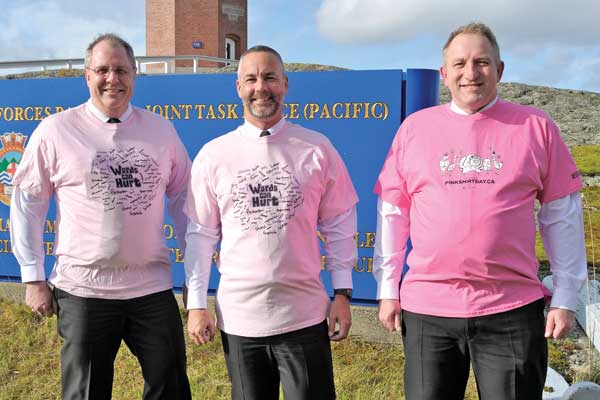
Stand up to bullying with Pink Shirt Day
[caption id="attachment_5844" align="alignnone" width="300"] Maritime Forces Pacific (MARPAC) Commanding Officer RAdm Bill Truelove (centre), with Formation Chief CPO1 Paul Helston (left), and MARPAC Chief of Staff Capt(N) Mike Knippel (right) show their support for Pink Shirt Day.[/caption] What is bullying?Bullying is described as an act(s) or verbal comment(s) that could mentally hurt or isolate a person in the workplace.Sometimes, bullying can involve physical contact as well. Bullying can include, but is not limited to, repeated incidents or a pattern of behaviour that is intended to intimidate, offend, degrade or humiliate a particular person or group of people. It has also been described as the assertion of power through aggression.Some examples of bullying are:• Offensive jokes or comments• Insults• Belittling opinions• Withholding necessary information or intentionally giving misinformation• Excluding or isolating the target• Physical abuse or threats of abuseBullying in the workplace is often more subtle, and harmful, than direct verbal and physical abuse. Bullying behaviours are toxic not only to the individual and their family and friends, but also to bystanders and the entire organization. What to do if you feel bulliedThere are a number of steps you can take if you are feeling bullied by someone at work. If you feel safe doing so, talk firmly to the bully about stopping the unwanted behaviour. You may wish to arrange a witness to be present for this conversation. Make sure you keep a factual journal with detailed descriptions of the events- including date, time, witnesses, and outcome. Ensure you keep copies of any written communication from this person.Keep job appraisals and performance reviews.If bullying persists, talk to a trusted supervisor, a union representative, the Good Working Relations Advisors, the Unit Harassment Advisors, General Safety Officers, or the Employee Assistance Program to make a plan of action, but do not retaliate.What...
































